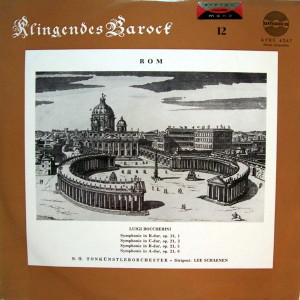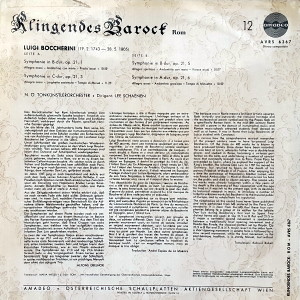 |
1 LP -
Amadeo AVRS 6367
|
 |
|
| ROM -
Klingendes Barock - 12 |
|
|
|
|
|
| Luigi Boccherini
(19.2.1743 - 28.5.1805) |
|
|
| Symphonie in
B-dur, op. 21, 1 |
10' 50" |
A1 |
| - Allegro assai
· Andantino con moto · Presto
assai |
|
|
| Symphonie in
C-dur, op. 21, 3 |
11' 25" |
A2 |
| -
Allegro assai · Larghetto
sostenuto · Tempo di Minué |
|
|
| Symphonie
in B-dur, op. 21, 5 |
10' 07" |
B1 |
| - Allegro
spiritoso · Andantino con moto ·
Vivace assai |
|
|
| Symphonie in
A-dur, op. 21, 6 |
10' 53"
|
B2 |
| -
Allegro assai · Andantino
grazioso · Tempo di minuetto |
|
|
|
|
|
| N. Ö.
TONKÜNSTLERORCHESTER
/ Lee
Schaenen,
Dirigent
|
|
|
|
|
|
Luogo
e data di registrazione |
|
- |
|
|
Registrazione:
live / studio |
|
studio |
|
|
Edizione LP |
|
AMADEO
- AVRS 6367 - (1 lp) - durata 43'
15" - (p) 1966 - Analogico |
|
|
Altre edizioni
LP
|
|
MUSICAL
HERITAGE SOCIETY - MHS 651 - (1
lp) |
|
|
Prima Edizione
CD |
|
- |
|
|
Note |
|
Stereo
compatibile
|
|
|
|
|
The baroque
era in Rome meant
a brilliant
artistic upsurge.
Both inwardly and
outwardly the
classical heritage
and a specifically
Roman form. In the
mid-18th century
Rome was still a
power in the
domain of
instrumental
music, and Roman
music-schools
attracted students
from abroad
as well as
at home. It was in
Rome that Luigi
Boccherini of
Lucca studied with
Constanzi.
It
is curios how
the
comprehensive
musical
researches of
the present
century seem to
have by-passed
Luigi
Boccherini. Of
the close on 400
works he is
known to have
produced barely
three dosen have
been recorded.
He was born at
Lucca, where his
father was a
double-bass
player, and
studied in Rome,
becoming a
virtuose
perfermer on the
cello and
undertaking a
number of
concert tours
that eventually
brought him to
Paris. From
Paris he
proceeded to
Spain, where he
enjoyed the
support of the
King's brother,
the Infante
Don Luis. In
1787 he moved
to Germany,
but returned
to Spain on
the death of
his patron,
Friedrich
Wilhelm II of
Prussia. After
enjoying for a
time the
patronage of
Napoleon's
brother
Lucien, who
was French
Ambassador in
Madrid,
Boccherini
lost his hold
on the public
and died in
abject
poverty. The
reason why his
works were
already
forgotten
within a few
years of his
death is the
closeness of
their
association
with the age
he lived in.
It was left to
the present
age, with its
devotion to
historical
research in
music, to
introduce a
number of
hitherto
unknown works
by Boccherini
to the musical
public of
Europe, and to
rehabilitate
his
reputation.
The
symphonies on
this record
have never
been published
and were
performed from
MS material in
the Paris
Conservatoire.
It is clear
from the MS
that these
four
symphonies
belong to a
group of six
written for
the Infante
Don Luis
during
Boccherini's
first visit to
Spain. Two
distinct forms
are used. In
Op. 21/1 in B
flat and 21/5
in C ,ajor a
cantabile
second
movement is
sandwiched
between a
traditionally
brief opening
movement and a
Rondo-like
Finale, the
classical
pattern set by
Haydn. Op.
21/3 in B flat
and 21/6 in A
major revert
to the older
form: a short
opening
movement in
sonata form is
followed by a
slow second
movement,
while the
final
movement, in
the
post-baroque
tradition, is
a sturdy
Minuet, but
without a
Trio.
Alfons
Übelhör
(Translation:
Richard
Rickett)
|
|

